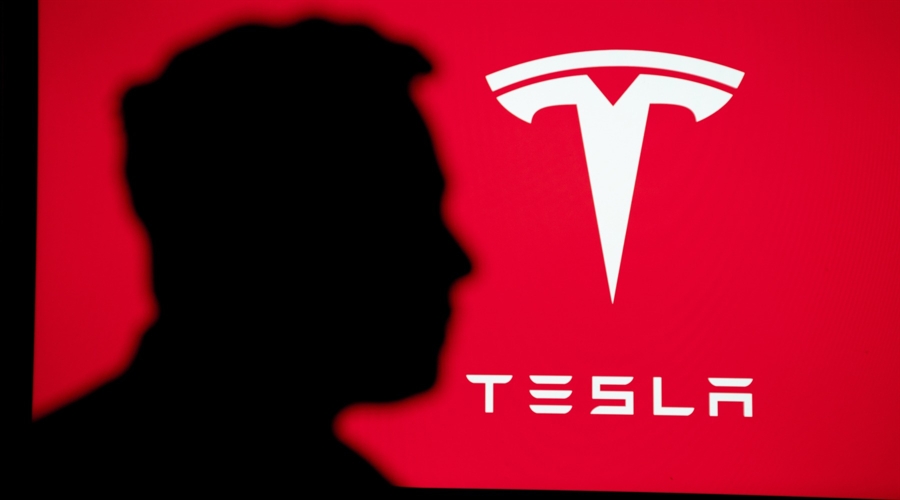Tesla share price (NASDAQ: TSLA) plummeted 7% in just two trading days, dropping from $323.63 on Friday to $300.71 by Tuesday’s close, as investors grappled with a renewed feud between CEO Elon Musk and President Donald Trump.
The electric vehicle giant now faces a perfect storm of political uncertainty and disappointing delivery expectations, creating significant headwinds for the stock that had surged 90% in June 2025.
The timing couldn’t be worse for Tesla, with the company set to report second-quarter delivery figures on Wednesday morning. Wall Street analysts anticipate deliveries of approximately 387,000 vehicles, representing a 13% year-over-year decline from the nearly 444,000 deliveries reported in the same period last year.
Let’s check why Tesla stock is down today and what the newest Tesla share price predictions are for 2025 and beyond.
Tesla news: Political Feud Triggers Immediate Selloff
The latest Tesla stock decline stems directly from President Trump’s explosive Truth Social post on Monday night, where he suggested the Department of Government Efficiency should investigate Musk’s subsidies.
“Elon may get more subsidy than any human being in history, by far, and without subsidies, Elon would probably have to close up shop and head back home to South Africa,” Trump declared.
This public confrontation marks the second major political clash between the two figures in 2025. The previous feud in early June caused Tesla shares to sink 18% in a single day before recovering some losses. However, the current dispute appears more serious, with Trump explicitly threatening to target Musk’s business empire through government policy changes.
The president’s comments carry particular weight given Tesla’s heavy reliance on government support. The company has reported $11.8 billion in automotive regulatory credit sales since 2015, with these credits accounting for approximately 60% of Tesla’s net income in Q2 2024. Meanwhile, SpaceX has received over $22 billion in federal contracts since 2008, highlighting the vulnerability of Musk’s business empire to political winds.
Why Tesla Stock Is Down Today? Delivery Disappointment Looms Large
Beyond political drama, Tesla faces fundamental business challenges that explain why the stock continues declining. UBS maintains a “sell” rating with a target price of just $215 per share, projecting Q2 deliveries of approximately 366,000 units – an 18% year-over-year decrease.
The delivery decline reflects broader struggles in Tesla’s core automotive business. European sales dropped 45% in January compared to the previous year, while reports indicate declining sales in China and Australia. Even in California, Tesla’s home market, the company’s EV market share has fallen below 50% for the first time, signaling intensifying competition.
Tesla’s automotive margins have also compressed significantly from post-pandemic highs. The company’s Q4 2024 automotive revenue decreased 8% year-over-year to $19.8 billion, while operating profit fell 23% to $1.6 billion. These margin pressures stem from aggressive price cuts implemented to maintain market share amid growing competition.
Market Forces Beyond Tesla’s Control
Tesla’s stock decline reflects broader market dynamics that extend beyond company-specific factors. The S&P 500 dropped 9.28% in Q2 2025, creating headwinds for growth stocks like Tesla. Additionally, ongoing U.S.-China trade tensions and macroeconomic uncertainties continue pressuring the automotive sector.
The proposed “One Big Beautiful Bill” legislation adds another layer of uncertainty. The spending bill includes provisions that would cut hundreds of billions in renewable energy support and phase out EV tax credits, potentially reducing Tesla sales by approximately 100,000 vehicles annually by 2035. These policy changes could significantly impact both Tesla’s automotive and energy storage divisions.
TSLA Technical Analysis Points to New All-Time High
The stock’s technical indicators signal potential weakness. After reaching an all-time high of $320 per share in December 2024 following Trump’s election victory, Tesla has now declined 38.20% from those peaks. The year-to-date performance shows a 22% decline, despite the remarkable June surge that temporarily boosted investor confidence.
However, based on my technical analysis, Tesla’s stock price is currently testing a critical level, the psychological barrier of $300. This level is further reinforced by the 200-period exponential moving average (EMA). It’s also worth noting that the price action is unfolding within a broader support zone, defined by the $290 level, which aligns with local highs from March and April of this year. This zone is further strengthened by the 23.6% Fibonacci retracement level, measured from the downward trend that began in late December 2024 and extended to the April 2025 lows.
You may also like: How High Can Tesla Stock Go? “Golden Cross” Bullish Pattern Predicts New Price ATH for Musk’s Company
This area marks the lower boundary of a consolidation range that stretches down to around $280, as last adjusted in early June. The upper boundary of this structure currently lies near $317, and it is within this range that Tesla shares are now moving—and likely will continue to move in the near term. A breakout above this range would require the price to reclaim the 200 EMA, followed by the 50-day moving average and then challenge the next resistance zone between $320 and $325.
The technical outlook also presents a strongly bullish scenario when using Fibonacci extensions based on the previous upward trend. According to this model, the target area for Tesla’s stock price lies above $520, which corresponds to the 161.8% Fibonacci extension. Reaching this level would imply a breakout above the previous all-time high from December, located around $488, and suggest a potential upside of more than 70% from current levels.
Tesla Share Price Prediction: Analyst Perspectives Remain Divided
Despite current challenges, some analysts maintain optimistic long-term views on Tesla. The company’s forward P/E ratio of 62 reflects continued investor confidence in AI-driven growth prospects, particularly around Full Self-Driving technology and robotaxi services. Tesla’s recent launch of limited robotaxi service in Austin, Texas, generated initial enthusiasm before political concerns overshadowed operational progress.
However, valuation concerns persist. Tesla trades at a P/E ratio of 120 compared to the industry average of 15, making the stock vulnerable to any disappointment in growth expectations. Wells Fargo previously predicted a 61% stock price drop due to fundamental business challenges, though Tesla’s Q1 2025 earnings helped stabilize sentiment temporarily.
The analyst community remains split on Tesla’s prospects, with 16 analysts rating it a “Buy,” 10 rating it “Hold,” and 11 rating it “Sell” out of 37 total coverage. The median Wall Street price target of $285.97 suggests potential downside from current levels, though several prominent firms maintain significantly higher targets
2025 Tesla Stock Price Predictions by Major Analysts
The wide divergence in analyst opinions stems from differing views on Tesla’s core business transformation. Bulls like Wedbush maintain price targets up to $650, citing the company’s AI initiatives and potential regulatory fast-tracking of robotaxi services under the Trump administration. Conversely, bears point to intensifying competition and margin compression as reasons for more conservative targets.
Morgan Stanley’s Adam Jonas recently reiterated his $410 price target with a “Buy” rating, arguing that recent EV tax-credit cuts won’t significantly impact Tesla’s long-term trajectory. The firm believes Tesla’s strengths in AI, robotics, and renewable energy infrastructure will drive future growth despite near-term political headwinds.
Looking Ahead: Key Catalysts and Risks for Tesla
Tesla’s immediate future hinges on several critical factors. Wednesday’s Q2 delivery report will provide crucial insight into demand trends and competitive positioning. The company’s Q2 2025 earnings call, scheduled for July 29, will offer management’s perspective on political risks and business fundamentals.
The resolution of the Trump-Musk feud remains paramount for investor confidence. As Wedbush analyst Dan Ives noted, the political tension “puts massive pressure on Tesla shares with fears that Trump will turn from friend to foe and create a tough regulatory environment.”
Tesla’s robotaxi expansion and FSD technology development continue as long-term growth drivers. The company reported a 25% increase in FSD subscription rates in Q1, suggesting growing consumer acceptance of autonomous driving features. However, regulatory approval for fully autonomous vehicles remains subject to political considerations.
Tesla stock faces a challenging period as political uncertainty compounds fundamental business headwinds. The combination of declining deliveries, margin pressure, and potential subsidy cuts creates a perfect storm for continued weakness. While long-term AI and energy opportunities remain compelling, near-term catalysts appear limited until political tensions resolve and delivery trends stabilize.
Investors should monitor Wednesday’s delivery announcement closely, as disappointing figures could accelerate the current decline toward UBS’s $215 target price. Conversely, better-than-expected deliveries might provide temporary relief, though structural challenges in the EV market and political risks will likely continue weighing on the stock throughout 2025.
Tesla News FAQ
Why Has Tesla Stock Been Going Down?
Tesla stock has declined 7% in just two trading days due to a perfect storm of factors. The primary catalyst is the renewed political feud between CEO Elon Musk and President Trump, triggered by Trump’s Truth Social post threatening to cut Musk’s subsidies.
Why Is Tesla Losing?
Tesla is facing multiple headwinds that explain its recent struggles. The company’s European sales dropped 45% in January compared to the previous year, while its California market share has fallen below 50% for the first time. Tesla’s automotive revenue decreased 8% year-over-year to $19.8 billion in Q4 2024, with operating profit falling 23% to $1.6 billion.
How Much Will Tesla Stock Be Worth in 2025?
Analyst predictions for Tesla’s 2025 stock price vary dramatically, ranging from a bearish $249.76 to an extremely bullish $1,109. The median Wall Street price target sits at $285.97, suggesting potential downside from current levels. Major firms show significant divergence: Wedbush maintains targets up to $650, Morgan Stanley projects $410, while UBS forecasts $291.31. The wide spread of $859.24 between the highest and lowest targets reflects fundamental uncertainty about Tesla’s trajectory amid political turmoil and evolving market dynamics.
Is Tesla Stock Predicted to Go Up?
Analyst opinions remain deeply divided on Tesla’s direction. Out of 37 analysts covering the stock, 16 rate it a “Buy,” 10 rate it “Hold,” and 11 rate it “Sell”. Bulls like Wedbush cite AI initiatives and potential regulatory fast-tracking of robotaxi services, while bears point to intensifying competition and margin compression. The median price target of $285.97 suggests limited upside potential, though some firms like Morgan Stanley maintain “Buy” ratings with 32.86% upside potential.
What Is the 12 Month Stock Forecast for Tesla?
The 12-month outlook for Tesla remains highly uncertain given current political and business challenges. Revenue projections show more consensus, with analysts collectively forecasting a 17.5% increase to $117.2 billion for 2025. However, delivery estimates vary significantly, with Barclays projecting 1.95 million units compared to Bloomberg’s consensus of 2.08 million.
Where Will Tesla Be in 10 Years?
Tesla’s long-term prospects hinge on successful execution of its AI and energy diversification strategy. The company’s energy storage business is projected to grow profits tenfold by 2030, providing crucial revenue diversification beyond automotive. Tesla reported a 25% increase in FSD subscription rates in Q1, suggesting growing consumer acceptance of autonomous driving features.
This article was written by Damian Chmiel at www.financemagnates.com.TrendingRead More
You might also be interested in reading JPMorgan Chase starts first round in series of layoffs – report.



